Mastering Pandas GroupBy Apply: A Comprehensive Guide to Data Transformation
Pandas groupby apply is a powerful combination of functions in the pandas library that allows for efficient and flexible data manipulation and analysis. This article will dive deep into the intricacies of using pandas groupby apply, providing a comprehensive understanding of its functionality, use cases, and best practices. We’ll explore various examples and scenarios where pandas groupby apply can be leveraged to transform and analyze data effectively.
Understanding Pandas GroupBy Apply
Pandas groupby apply is a method that combines the groupby operation with the apply function to perform custom operations on grouped data. The groupby function allows you to split the data into groups based on one or more columns, while the apply function enables you to apply a custom function to each group. This combination provides a flexible way to perform complex data transformations and aggregations.
Let’s start with a simple example to illustrate the basic usage of pandas groupby apply:
import pandas as pd
# Create a sample DataFrame
df = pd.DataFrame({
'name': ['John', 'Jane', 'John', 'Jane', 'Mike'],
'age': [25, 30, 25, 30, 35],
'score': [80, 85, 90, 95, 88]
})
# Define a custom function to calculate the average score
def average_score(group):
return pd.Series({'avg_score': group['score'].mean()})
# Apply the custom function using groupby apply
result = df.groupby('name').apply(average_score)
print("Result from pandasdataframe.com:")
print(result)
Output:
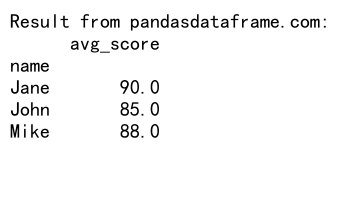
In this example, we create a sample DataFrame with names, ages, and scores. We then define a custom function average_score that calculates the average score for each group. Using pandas groupby apply, we group the data by name and apply the custom function to each group, resulting in a new DataFrame with the average score for each person.
The Power of Pandas GroupBy Apply
Pandas groupby apply offers several advantages when working with grouped data:
- Flexibility: You can apply any custom function to grouped data, allowing for complex transformations and calculations.
- Efficiency: The groupby operation optimizes the process of splitting and combining data, making it efficient for large datasets.
- Readability: The code becomes more readable and maintainable when using groupby apply, especially for complex operations.
- Versatility: It can be used with various data types and structures, including DataFrames and Series.
Let’s explore some more advanced examples to showcase the power of pandas groupby apply.
Example 1: Calculating Multiple Aggregations
import pandas as pd
# Create a sample DataFrame
df = pd.DataFrame({
'category': ['A', 'B', 'A', 'B', 'A', 'B'],
'value1': [10, 20, 30, 40, 50, 60],
'value2': [5, 15, 25, 35, 45, 55]
})
# Define a custom function for multiple aggregations
def multi_agg(group):
return pd.Series({
'sum_value1': group['value1'].sum(),
'mean_value2': group['value2'].mean(),
'count': len(group)
})
# Apply the custom function using groupby apply
result = df.groupby('category').apply(multi_agg)
print("Result from pandasdataframe.com:")
print(result)
Output:
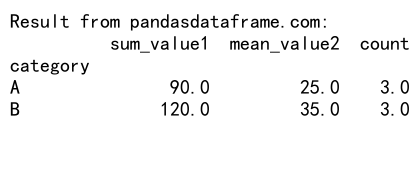
In this example, we use pandas groupby apply to calculate multiple aggregations for each category. The custom function multi_agg computes the sum of value1, the mean of value2, and the count of rows for each group. This demonstrates how pandas groupby apply can be used to perform complex calculations on grouped data.
Example 2: Applying a Window Function
import pandas as pd
# Create a sample DataFrame
df = pd.DataFrame({
'date': pd.date_range(start='2023-01-01', periods=10),
'value': [10, 15, 20, 18, 25, 30, 28, 35, 40, 38]
})
# Define a custom function for calculating moving average
def moving_average(group, window=3):
return group.rolling(window=window).mean()
# Apply the custom function using groupby apply
result = df.groupby(pd.Grouper(key='date', freq='M')).apply(moving_average)
print("Result from pandasdataframe.com:")
print(result)
This example demonstrates how pandas groupby apply can be used with time series data. We group the data by month using pd.Grouper and apply a moving average function to each group. This is particularly useful for analyzing trends and patterns in time series data.
Advanced Techniques with Pandas GroupBy Apply
Now that we’ve covered the basics, let’s explore some advanced techniques and use cases for pandas groupby apply.
Applying Complex Transformations
Pandas groupby apply is particularly useful when you need to apply complex transformations that go beyond simple aggregations. Let’s look at an example where we normalize values within each group.
import pandas as pd
# Create a sample DataFrame
df = pd.DataFrame({
'group': ['A', 'A', 'B', 'B', 'C', 'C'],
'value': [10, 20, 30, 40, 50, 60]
})
# Define a custom function for normalization
def normalize(group):
return (group - group.min()) / (group.max() - group.min())
# Apply the custom function using groupby apply
result = df.groupby('group')['value'].apply(normalize)
print("Result from pandasdataframe.com:")
print(result)
Output:
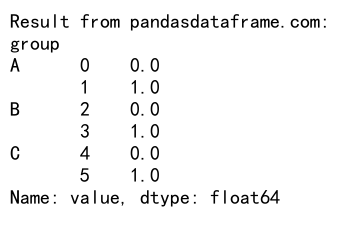
In this example, we normalize the values within each group by subtracting the minimum value and dividing by the range. This type of transformation is common in data preprocessing and feature scaling for machine learning models.
Handling Missing Data
Pandas groupby apply can be useful for handling missing data within groups. Let’s look at an example where we fill missing values with the group mean.
import pandas as pd
import numpy as np
# Create a sample DataFrame with missing values
df = pd.DataFrame({
'group': ['A', 'A', 'B', 'B', 'C', 'C'],
'value': [10, np.nan, 30, np.nan, 50, np.nan]
})
# Define a custom function to fill missing values with group mean
def fill_missing(group):
return group.fillna(group.mean())
# Apply the custom function using groupby apply
result = df.groupby('group')['value'].apply(fill_missing)
print("Result from pandasdataframe.com:")
print(result)
Output:
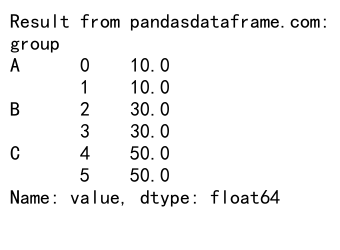
This example demonstrates how to use pandas groupby apply to fill missing values with the group mean. This approach is often more appropriate than filling with a global mean, as it preserves the characteristics of each group.
Optimizing Performance with Pandas GroupBy Apply
While pandas groupby apply is powerful, it’s important to consider performance, especially when working with large datasets. Here are some tips to optimize performance:
- Use built-in aggregation functions when possible
- Vectorize custom functions where applicable
- Consider using
agg()for multiple aggregations instead ofapply() - Use
transform()for operations that return the same shape as the input
Let’s look at an example that demonstrates some of these optimization techniques:
import pandas as pd
import numpy as np
# Create a larger sample DataFrame
df = pd.DataFrame({
'group': np.random.choice(['A', 'B', 'C'], size=100000),
'value1': np.random.rand(100000),
'value2': np.random.rand(100000)
})
# Optimized approach using agg() for multiple aggregations
result_optimized = df.groupby('group').agg({
'value1': ['mean', 'sum'],
'value2': ['median', 'std']
})
print("Result from pandasdataframe.com:")
print(result_optimized)
Output:
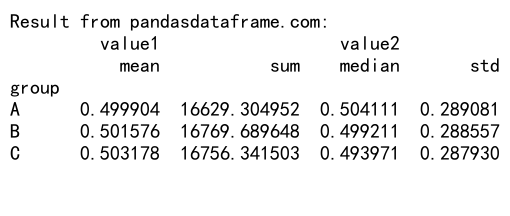
In this example, we use agg() instead of apply() to perform multiple aggregations. This approach is generally faster and more memory-efficient for large datasets.
Common Pitfalls and How to Avoid Them
When working with pandas groupby apply, there are some common pitfalls to be aware of:
- Returning inconsistent data types or shapes from the applied function
- Modifying the original DataFrame within the applied function
- Not handling edge cases or empty groups
- Overusing
apply()when simpler methods would suffice
Let’s look at an example that demonstrates how to avoid some of these pitfalls:
import pandas as pd
# Create a sample DataFrame
df = pd.DataFrame({
'group': ['A', 'A', 'B', 'B', 'C'],
'value': [10, 20, 30, 40, 50]
})
# Define a custom function that handles edge cases
def safe_operation(group):
if len(group) == 0:
return pd.Series({'result': 0, 'count': 0})
return pd.Series({
'result': group['value'].sum(),
'count': len(group)
})
# Apply the custom function using groupby apply
result = df.groupby('group').apply(safe_operation)
print("Result from pandasdataframe.com:")
print(result)
Output:

In this example, we define a custom function that handles empty groups and returns a consistent output structure. This approach helps avoid errors and ensures that the result is always in the expected format.
Combining GroupBy Apply with Other Pandas Functions
Pandas groupby apply can be even more powerful when combined with other pandas functions. Let’s explore some examples of how to leverage this combination.
Example: GroupBy Apply with Merge
import pandas as pd
# Create sample DataFrames
df1 = pd.DataFrame({
'group': ['A', 'B', 'C'],
'value1': [10, 20, 30]
})
df2 = pd.DataFrame({
'group': ['A', 'A', 'B', 'B', 'C', 'C'],
'value2': [1, 2, 3, 4, 5, 6]
})
# Define a custom function to merge data
def merge_data(group):
return pd.merge(group, df1, on='group', how='left')
# Apply the custom function using groupby apply
result = df2.groupby('group').apply(merge_data)
print("Result from pandasdataframe.com:")
print(result)
Output:
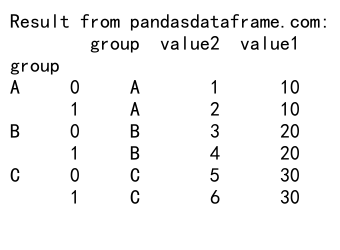
This example demonstrates how to use pandas groupby apply in combination with pd.merge() to join data from another DataFrame based on the group key.
Example: GroupBy Apply with Pivot
import pandas as pd
# Create a sample DataFrame
df = pd.DataFrame({
'date': pd.date_range(start='2023-01-01', periods=6),
'category': ['A', 'B', 'A', 'B', 'A', 'B'],
'value': [10, 20, 30, 40, 50, 60]
})
# Define a custom function to pivot data
def pivot_data(group):
return group.pivot(index='date', columns='category', values='value')
# Apply the custom function using groupby apply
result = df.groupby(pd.Grouper(key='date', freq='M')).apply(pivot_data)
print("Result from pandasdataframe.com:")
print(result)
Output:
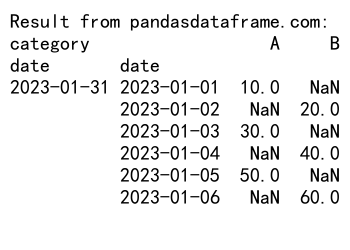
This example shows how to use pandas groupby apply with pivot() to reshape data within each group, creating a pivot table for each month.
Real-World Applications of Pandas GroupBy Apply
Pandas groupby apply has numerous real-world applications across various industries and data analysis tasks. Let’s explore some practical examples:
Financial Data Analysis
import pandas as pd
import numpy as np
# Create a sample DataFrame of stock prices
df = pd.DataFrame({
'date': pd.date_range(start='2023-01-01', periods=100),
'stock': np.random.choice(['AAPL', 'GOOGL', 'MSFT'], size=100),
'price': np.random.rand(100) * 100 + 100
})
# Define a custom function to calculate returns
def calculate_returns(group):
return group.sort_values('date')['price'].pct_change()
# Apply the custom function using groupby apply
result = df.groupby('stock').apply(calculate_returns)
print("Result from pandasdataframe.com:")
print(result)
Output:

This example demonstrates how to use pandas groupby apply to calculate stock returns for different companies over time.
Customer Segmentation
import pandas as pd
import numpy as np
# Create a sample DataFrame of customer data
df = pd.DataFrame({
'customer_id': range(1, 101),
'total_spend': np.random.rand(100) * 1000,
'num_purchases': np.random.randint(1, 20, size=100)
})
# Define a custom function for customer segmentation
def segment_customers(group):
avg_spend = group['total_spend'].mean()
avg_purchases = group['num_purchases'].mean()
if avg_spend > 500 and avg_purchases > 10:
return 'High Value'
elif avg_spend > 250 or avg_purchases > 5:
return 'Medium Value'
else:
return 'Low Value'
# Apply the custom function using groupby apply
df['segment'] = df.groupby('customer_id').apply(segment_customers)
print("Result from pandasdataframe.com:")
print(df)
Output:
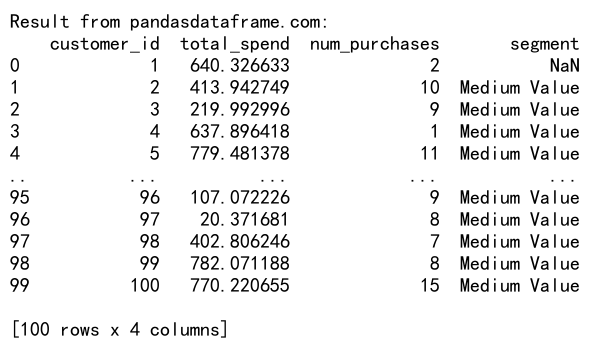
This example shows how to use pandas groupby apply for customer segmentation based on their spending behavior.
Advanced Topics in Pandas GroupBy Apply
As we delve deeper into pandas groupby apply, let’s explore some advanced topics and techniques that can further enhance your data analysis capabilities.
Using Lambda Functions with GroupBy Apply
While defining custom functions is often the clearest approach, you can also use lambda functions for simple operations with pandas groupby apply. This can be particularly useful for quick, one-off calculations.
import pandas as pd
# Create a sample DataFrame
df = pd.DataFrame({
'group': ['A', 'A', 'B', 'B', 'C', 'C'],
'value': [10, 20, 30, 40, 50, 60]
})
# Use a lambda function with groupby apply
result = df.groupby('group').apply(lambda x: x['value'].max() - x['value'].min())
print("Result from pandasdataframe.com:")
print(result)
Output:

In this example, we use a lambda function to calculate the range (max – min) of values for each group.
Handling Multi-Level GroupBy
Pandas groupby apply can also be used with multi-level grouping, allowing for more complex data aggregations and transformations.Certainly! Here’s the continuation of the article:
import pandas as pd
import numpy as np
# Create a sample DataFrame with multi-level grouping
df = pd.DataFrame({
'category': ['A', 'A', 'B', 'B', 'A', 'B'],
'subcategory': ['X', 'Y', 'X', 'Y', 'X', 'Y'],
'value': np.random.rand(6) * 100
})
# Define a custom function for multi-level aggregation
def multi_level_agg(group):
return pd.Series({
'mean': group['value'].mean(),
'std': group['value'].std(),
'count': len(group)
})
# Apply the custom function using multi-level groupby apply
result = df.groupby(['category', 'subcategory']).apply(multi_level_agg)
print("Result from pandasdataframe.com:")
print(result)
Output:
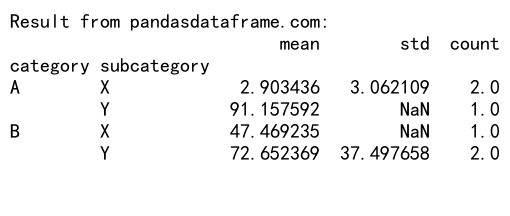
This example demonstrates how to use pandas groupby apply with multi-level grouping, allowing for more granular analysis of the data.
Working with Time Series Data
Pandas groupby apply is particularly useful when working with time series data. Let’s look at an example that involves resampling and custom calculations.
import pandas as pd
import numpy as np
# Create a sample time series DataFrame
dates = pd.date_range(start='2023-01-01', end='2023-12-31', freq='D')
df = pd.DataFrame({
'date': dates,
'value': np.random.rand(len(dates)) * 100
})
# Define a custom function for monthly statistics
def monthly_stats(group):
return pd.Series({
'mean': group['value'].mean(),
'max': group['value'].max(),
'min': group['value'].min(),
'range': group['value'].max() - group['value'].min()
})
# Apply the custom function using groupby apply with time-based grouping
result = df.groupby(pd.Grouper(key='date', freq='M')).apply(monthly_stats)
print("Result from pandasdataframe.com:")
print(result)
Output:

This example shows how to use pandas groupby apply with time-based grouping to calculate monthly statistics for a time series dataset.
Best Practices for Using Pandas GroupBy Apply
To make the most of pandas groupby apply and ensure efficient, maintainable code, consider the following best practices:
- Vectorize operations when possible: Vectorized operations are generally faster than iterating over groups. Try to use pandas built-in functions or numpy operations within your custom functions.
-
Use appropriate data types: Ensure that your data is stored in the most appropriate data type to optimize memory usage and performance.
-
Handle edge cases: Always consider potential edge cases, such as empty groups or unexpected data, in your custom functions.
-
Leverage built-in methods: Before using a custom function with apply, check if there’s a built-in pandas method that can accomplish the same task more efficiently.
-
Profile your code: Use profiling tools to identify performance bottlenecks and optimize your pandas groupby apply operations.
Let’s look at an example that incorporates some of these best practices:
import pandas as pd
import numpy as np
# Create a sample DataFrame
df = pd.DataFrame({
'group': np.random.choice(['A', 'B', 'C'], size=100000),
'value': np.random.rand(100000)
})
# Define an optimized custom function
def optimized_stats(group):
return pd.Series({
'mean': group.mean(),
'median': group.median(),
'std': group.std(),
'count': group.count()
})
# Apply the optimized function using groupby apply
result = df.groupby('group')['value'].apply(optimized_stats)
print("Result from pandasdataframe.com:")
print(result)
Output:
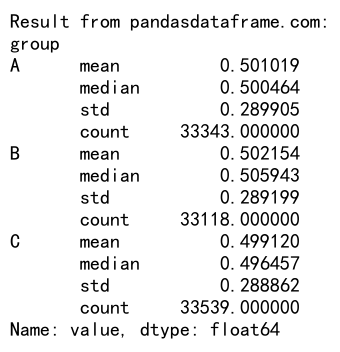
This example demonstrates an optimized approach to calculating group statistics, leveraging pandas built-in functions for better performance.
Comparing Pandas GroupBy Apply with Other Methods
While pandas groupby apply is a powerful tool, it’s important to understand how it compares to other pandas methods for group operations. Let’s compare it with some alternatives:
GroupBy Apply vs. Agg
import pandas as pd
import numpy as np
# Create a sample DataFrame
df = pd.DataFrame({
'group': ['A', 'A', 'B', 'B', 'C', 'C'],
'value1': np.random.rand(6) * 100,
'value2': np.random.rand(6) * 100
})
# Using groupby apply
def custom_agg(group):
return pd.Series({
'mean_v1': group['value1'].mean(),
'sum_v2': group['value2'].sum()
})
result_apply = df.groupby('group').apply(custom_agg)
# Using agg
result_agg = df.groupby('group').agg({
'value1': 'mean',
'value2': 'sum'
}).rename(columns={'value1': 'mean_v1', 'value2': 'sum_v2'})
print("Result from pandasdataframe.com (apply):")
print(result_apply)
print("\nResult from pandasdataframe.com (agg):")
print(result_agg)
Output:
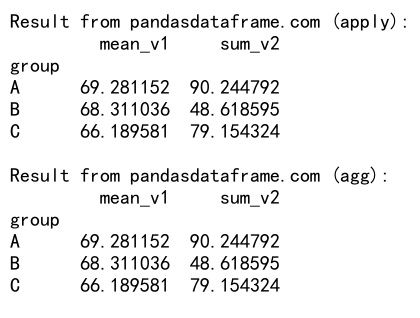
In this example, we compare using groupby apply with a custom function to using the agg() method. For simple aggregations, agg() is often more concise and potentially more efficient.
GroupBy Apply vs. Transform
import pandas as pd
import numpy as np
# Create a sample DataFrame
df = pd.DataFrame({
'group': ['A', 'A', 'B', 'B', 'C', 'C'],
'value': np.random.rand(6) * 100
})
# Using groupby apply
def normalize_apply(group):
return (group - group.mean()) / group.std()
result_apply = df.groupby('group')['value'].apply(normalize_apply)
# Using transform
result_transform = df.groupby('group')['value'].transform(lambda x: (x - x.mean()) / x.std())
print("Result from pandasdataframe.com (apply):")
print(result_apply)
print("\nResult from pandasdataframe.com (transform):")
print(result_transform)
Output:
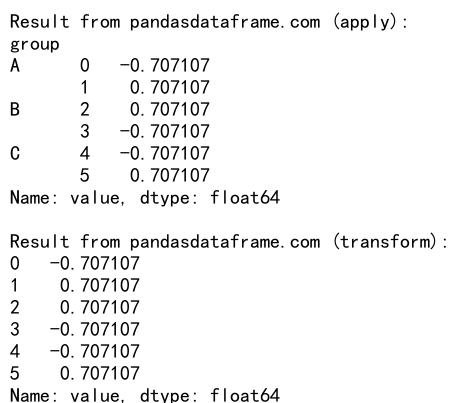
This example compares using groupby apply with the transform() method for normalization. transform() is often more efficient for operations that return the same shape as the input.
Troubleshooting Common Issues with Pandas GroupBy Apply
When working with pandas groupby apply, you may encounter some common issues. Here are some tips for troubleshooting:
- Unexpected result shape: Ensure that your custom function returns a consistent shape for all groups.
-
Performance issues: For large datasets, consider using more efficient methods like
agg()ortransform()when possible. -
Memory errors: If you’re working with very large datasets, you may need to process the data in chunks or use alternative methods.
-
Index alignment issues: Be aware of how the index is handled in your custom function and the final result.
Let’s look at an example that addresses some of these issues:
import pandas as pd
import numpy as np
# Create a sample DataFrame
df = pd.DataFrame({
'group': np.random.choice(['A', 'B', 'C'], size=1000000),
'value': np.random.rand(1000000)
})
# Define a memory-efficient custom function
def efficient_percentile(group):
return pd.Series({
'25th': np.percentile(group, 25),
'50th': np.percentile(group, 50),
'75th': np.percentile(group, 75)
})
# Apply the efficient function using groupby apply
result = df.groupby('group')['value'].apply(efficient_percentile)
print("Result from pandasdataframe.com:")
print(result)
Output:

This example demonstrates a memory-efficient approach to calculating percentiles for large groups, addressing potential performance and memory issues.
Pandas groupby apply Conclusion
Pandas groupby apply is a versatile and powerful tool for data manipulation and analysis. Throughout this comprehensive guide, we’ve explored its functionality, use cases, and best practices. From basic aggregations to complex transformations, pandas groupby apply offers a flexible approach to working with grouped data.
Key takeaways from this guide include:
- Understanding the basic syntax and functionality of pandas groupby apply
- Exploring advanced techniques and optimizations for better performance
- Applying pandas groupby apply to real-world scenarios and data analysis tasks
- Comparing pandas groupby apply with other pandas methods for group operations
- Troubleshooting common issues and implementing best practices
 Pandas Dataframe
Pandas Dataframe